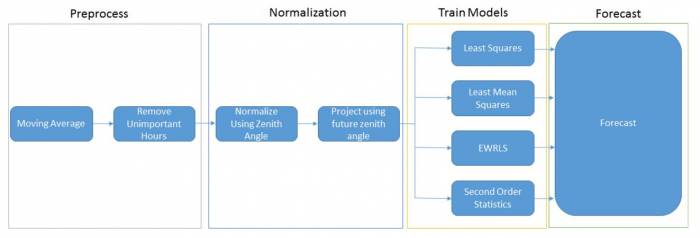This is an old revision of the document!
Forecasting
Updated: 1/19/2016
Forecasting focuses on creating a statistical model from data and then using it to predict future trends based on the test data. It is considered a field of data science/statistics. There is also a large craze concerning machine learning recently–the purpose of this team is to learn to adapt statistical and machine learning analysis techniques to weather-related data.
Introduction
Machine learning and data science are two extremely popular fields right now. It has many different applications, from analyzing genetic data and correlating it to biological processes to recognizing different types of objects against a database and making use of layered neural networks for image recognition. Due to the scale of the internet and the march of progress concerning technology, there is a large amount of information that can be used as a basis for more complex and different models that are only possible with large amounts of data.
Part of SCEL's mission is to be able to predict the weather in order to optimize the use of electricity and perhaps even the generation of energy. Renewable energy sources are considered unreliable due to the weather itself–wind energy depends depends on the wind direction and speed; solar energy generation depends on the sunlight intensity and cloud patterns. This is where we come in: our forthcoming efforts are considered as one of the possible keypoints of SCEL's mission. Our primary source of data is to be the weather boxes that are developed as a part of SCEL, such as Apple, Cranberry, and Guava.
History
The SCEL Forecasting team was started in the Fall 2015 semester, headed by Jeremy Garcia under Dr. Anthony Kuh. In the prior months, a few people from the University of California, Santa Cruz, came down to give a presentation about the new iPython (and recently renamed then, Jupyter) platform. They expressed that the University of California system had invested quite heavily into the platform as an accessible, flexible, powerful, and convenient platform to teach analysis alongside the modern, Python programming language. Motivated to demo out this new platform for analysis, Dr. Kuh wanted the team to explore this platform and, with it, begin to learn more about machine learning, as it was a hot topic along with “big data” at the time.
Due to Dr Kuh's acceptance into the National Science Foundation (NSF) in 2017, the Forecasting team had been placed on the back-burner and was largely left untouched for several years. In 2020, the forecasting team was rebooted with the recruitment of graduate students Josh Renzo Claudio and Keolakanealohanokeakua Macloves.
Goals
*Spring 2020 Edit*
We will be focusing on reviewing various analytical models and techniques in order to give us a solid grounding in forecasting. To do this, we will make use of (hopefully) Jupyter (an interactive Python environment and platform) or the statistical programming language, R. Both have extensive support for statistics and machine learning. We will try to primarily focus on Python.
- Learn Jupyter (formerly iPython) and possibly some R.
- Learn and review various statistical techniques and models as applied in Python/R.
- Program a dynamically learning algorithm that will automatically predict, update linear coefficients and trim/add to the feature spaces needed for forecasting to all the weather boxes.
Resources
Jupyter
- Install iPython - Installation tutorial for iPython. Anaconda recommended for users new to Python.
Connecting MATLAB to a database
Meeting Minutes
Spring 2017 Meeting Minutes
Fall 2016 Meeting Minutes
Spring 2016 Meeting Minutes
Fall 2015 Meeting Minutes
Documentation and Notes
General iPython Notes
Linear Regression
Cross Validation
How to improve Predictions by doing nothing Large sets of Data
How we implemented moving averages and variancesmoving_average.pdf
Datasets
Presentations & Reports
Read More
- Visualization (Team)
